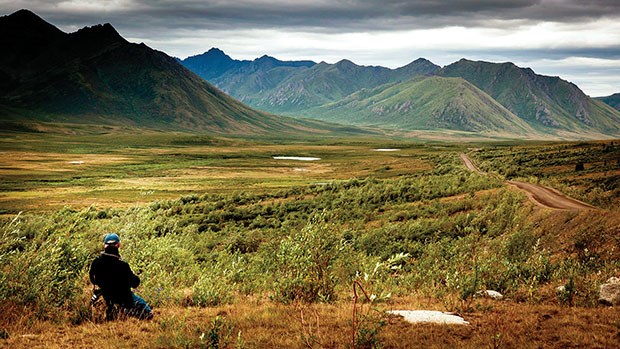They lean into each other.
With blackened windows and peeling paint, they are obviously abandoned. Yet next door, a modern cafe is abuzz with patrons. The contrast between these buildings encapsulates the boom and bust cycle of a Klondike Gold Rush town.
Four of us are exploring the many facets of Dawson City, Yukon. When Klaus can hardly find space to pin his hometown on the "Where are You From?" map at Klondike Kate's, we realize that many still flock to this northern outpost.
Dawson's first boom came in 1896, when news of gold discovered at Bonanza Creek started the rush. In a single season, Dawson City went from a tent city outpost on a mud flat flanked by the Klondike and Yukon rivers to a sprawling boom town with frame buildings and boardwalks. By 1898, it was the largest town west
of Winnipeg and north of Seattle and known as the "Paris of the North."
With over 300 businesses, including grocery and dress stores, blacksmiths, saloons and dance halls, it was the service and supply centre for thousands of prospectors. Now the town site is a National Historic Complex.
The Parks Canada guide behind the teller's cage in the restored bank tells us it was a safe town despite a rowdy population indulging in gambling and prostitution. Men readily brought their families to Dawson. The Northwest Mounted Police, well regarded for their integrity, confiscated firearms as stampeders came into town and order was maintained.
We have a sense of discovery while wandering the dusty roads. There are no paved streets or concrete sidewalks because the permafrost would cause them to heave. Buildings a century or more old are either decrepit, fixed up
just on the front and a ruin otherwise or are lovingly refurbished.
On the waterfront, the restored sternwheeler SS Keno holds pride of place. Paddle wheelers, with their shallow drafts, were ideal for plying the Yukon River. More than 60 paddle wheelers worked the route, transporting adventurers, ore, supplies and machinery.
We take an evening cruise on the Klondike
Spirit and pass the paddlewheel graveyard on the bank opposite Dawson. There, a number of paddle wheelers slowly disintegrate on the shore.
To further explore some of that empty space, we head north on the Dempster Highway. This 750-kilometre gravel challenge runs across the Arctic Circle to Inuvik. From its start, the next services are 370 kilometres away.
We only drive far enough to traverse Tombstone Territorial Park with its rugged mountain peaks. At the North Fork Pass summit, we are surrounded by rolling, velvet green tundra. It is a treeless plain, spongy with a thick layer of lichen and moss over near continuous permafrost.
Next day at the top of Midnight Dome, we have a panoramic view of the town, its rivers and its many
hillsides marked by mining.
For a closer look at where the boom started, we follow Bonanza Creek Road past abandoned homesteads and massive tailing piles made by dredges.
By 1905, machines had replaced men panning on the creeks. One such machine was Dredge No. 4. It is the largest woodenhulled bucket dredge in North America and it towers above us; two-thirds of a football field long and eight stories high. Dredge No. 4 could dig gold-bearing gravel at the rate of 22 buckets a minute and in its 46 years of operation, it unearthed nine tons of gold.
This valley has been continuously mined since the 1890s and there are active gold claims still. Maybe we should give gold panning a try; but would it be boom or bust for us?
Travel Writers' Tales is an independent travel article syndicate that offers professionally written travel articles to newspaper editors and publishers.



